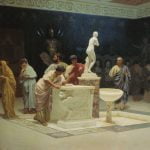The famous “Gardens of Maecenas” ( Horti1 Maecenatis), as the name suggests, arose on the initiative of Gaius Cilnius Maecenas, patron of art and culture in ancient Rome at the end of the 1st century BCE. They were one of the first such beautiful gardens in Rome; their creation was modelled on their Hellenistic and Persian counterparts.
Maecenas built his garden on Esquiline Hill, near to his luxury villa, placing them at the fortifications of the Servian walls (between Porta Esquilina and Porta Querquetulana) and the cemetery. This is one of the seven hills of Rome, which originally served as a cemetery for the poor. However, in 38 BCE the Roman senate banned the cremation of corpses 3 km from the centre of Rome. This meant that the Maecenas decided to buy the land and – in the opinion of researchers – start construction in the 30s.
One of the most important Roman aqueducts – Aqua Marcia – passed through the garden, which provided effective irrigation of the area and vegetation. According to Cassius Dion, Maecenas also built the first pool with hot water.
Due to the numerous sculptures found in and around the garden, it is suspected that Maecenas also had a real art gallery outside. Discovered among others the Demeter statue, the marble hermitage, the famous Laocoon Group, images of poets, the head of the Amazon and the centaur or a sculpture of a woman from the time of the Antonine. The gardens also had several marble fountains (including in the shape of the so-called Ryton – a horn for drinking wine).
In the gardens, there is the so-called Maecenas’ auditorium. The auditorium is a long, rectangular hall, ending with seven monumental, marble-covered stairs, in a semicircular apse. It is also suspected that there was a ramp inside that led guests to the underground level of the structure. The auditorium could have been a banquet hall (triclinium) which was adjacent to other residences. However, there are also voices suggesting that the building had a kind of nymphaeum, as evidenced by holes in the walls through which the pipes led water (even seals on them have survived); or a recitation room where many poets and writers (including Virgil or Horace) presented their works to Maecenas. This second concept was particularly popular at the end of the 19th century; it was suggested that the steps served as seats for listeners.
We know from historical records that emperor Augustus loved to be in Maecenas’ gardens when he was sick. Similarly rested here Tiberius in 2 CE, after his return to Rome. In 8 BCE, when the Maecenas died, the gardens fell into the hands of his friend Augustus, thus making them imperial estates. During the reign of Nero, these gardens were connected to the Palatine through the famous Domus Transitoria.








